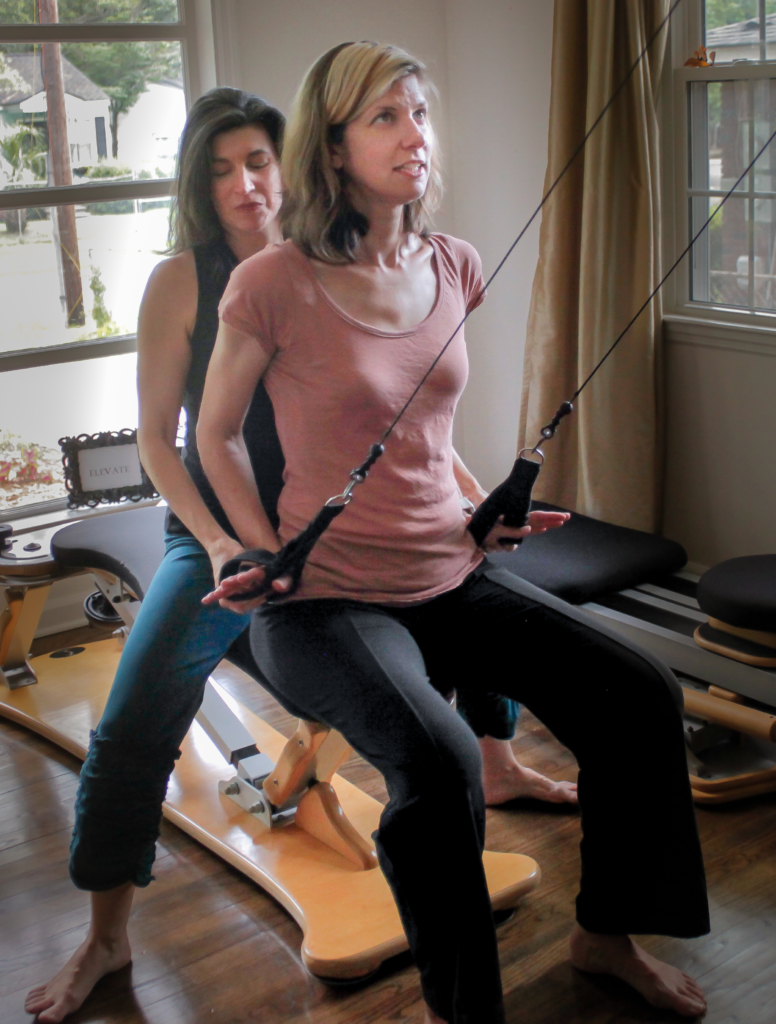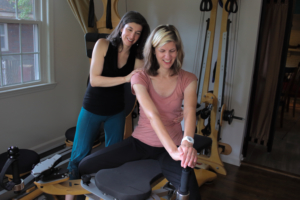Healing From Trauma With Movement – A Personal Experience
Blog Content Interviews Testimonial // July 25, 2017

By Holle Knowles
GYROTONIC® and GYROKINESIS® Trainer and Pre-Trainer
http://holleknowles.com/
Photos by: J. Alexander Photography
Chronic pain might not be a factor that we associate with being a survivor of trauma. However, the body holds our story, muscle memory bearing evidence of passages that we are not yet ready to acknowledge or are unsure how to address. This embodied history can bear silent witness to the devastating realities of trauma. Our bodies carry this through PTSD, which can most simply be described as being stuck in the cycle of fight or flight. This response is controlled by the sympathetic nervous system, which readies the body for threat by raising heart rate and blood pressure, putting us in a high alert state ready to defend or flee. The physical sensations of fight or flight also involve muscular tightness and increased inflammation that contribute to chronic pain. As a prisoner of the sympathetic nervous system, we experience perpetual fear, perceived danger, and disruptions in quality of sleep and digestion. Frequent nightmares and inability to get into deep sleep are not uncommon. We can feel captive to the past, afraid of the future, and rarely touch down in the present. Sometimes, exhuming the details of devastation can re-injure, deepening an already volatile wound. We may have needed the balm of numbness so as not to drown in the flood of grief and anger threatening to destroy us. It can become impossible to reach into the pain with words. As psychiatrist Dr. Bessel Van Der Kolk, a leading innovator on trauma treatment serving as the Medical Director of the Trauma Center at the Justice Resource Institute states, “if people need to overcome the trauma, we need to also find methods to bypass what they call the tyranny of language.” Ceasing to engage our loss verbally does not diminish the effect of trauma through prolonged activation of the sympathetic nervous system, which can manifest as PTSD and chronic pain.
The body, from which we feel estranged, the house of our woundedness, and a seeming accomplice in our violation, can be the very partner that we need to defeat PTSD and accompanying chronic pain. Using therapeutic movement, such as the GYROTONIC® progressions and the GYROKINESIS® Method, we engage the parasympathetic nervous system, which counteracts the sympathetic nervous system, disrupting the cycle of fight or flight, and moves us towards freedom. Dr. Van Der Kolk emphasizes choosing movement that engages our bodies in a mindful and purposeful way with attention to breathing to reset parts of the brain affected by trauma; “I always recommend that they (those healing from trauma) see somebody who helps them to really feel their body, experience their body, open up to their bodies.” These methods, full of lush, joyful, movement, invite us to come back home in our bodies. As we learn again to move, we begin to restore our sense of self, rediscovering our will, and reclaiming our authority.
 Traveling the world to observe the effects of trauma in different cultures, Ph.D. David Berceli recognizes that resilient populations intuitively recruit a shaking or shivering response after natural disasters, war time conditions, and personal trauma. Berceli’s research finds “this shaking mechanism seems to be a healthy and useful neurophysiological mechanism that appears to down regulate the nervous system, restore a sense of calmness and reducing the myofascial tensions that were created during the experience of … traumatic experiences.” In the Gyrotonic and Gyrokinesis journey, shivering can be a release to discharge the frantic fight or flight cycle. Fight or flight readies us for action, and is therefore discharged by action. After shivering, there is increased activity in the parasympathetic nervous system. Neurons are stimulated with the balanced muscular recruitment emphasized in these movements, creating better communication throughout the nervous system. Our bodies are designed to primarily use the parasympathetic nervous system reserving our sympathetic nervous system for life threatening situations. In PTSD, we cease to be able to distinguish fear, which we may feel all the time, from actual danger, causing our bodies to respond as if we are in perpetual risk. In utilizing the Gyrotonic and Gyrokinesis movements to ignite the parasympathetic nervous system, we step out of constant crisis to redeem our lives.
Traveling the world to observe the effects of trauma in different cultures, Ph.D. David Berceli recognizes that resilient populations intuitively recruit a shaking or shivering response after natural disasters, war time conditions, and personal trauma. Berceli’s research finds “this shaking mechanism seems to be a healthy and useful neurophysiological mechanism that appears to down regulate the nervous system, restore a sense of calmness and reducing the myofascial tensions that were created during the experience of … traumatic experiences.” In the Gyrotonic and Gyrokinesis journey, shivering can be a release to discharge the frantic fight or flight cycle. Fight or flight readies us for action, and is therefore discharged by action. After shivering, there is increased activity in the parasympathetic nervous system. Neurons are stimulated with the balanced muscular recruitment emphasized in these movements, creating better communication throughout the nervous system. Our bodies are designed to primarily use the parasympathetic nervous system reserving our sympathetic nervous system for life threatening situations. In PTSD, we cease to be able to distinguish fear, which we may feel all the time, from actual danger, causing our bodies to respond as if we are in perpetual risk. In utilizing the Gyrotonic and Gyrokinesis movements to ignite the parasympathetic nervous system, we step out of constant crisis to redeem our lives.
These movements pair with breathing patterns to engage beyond our pain, regulating our nervous system, slowing heart rate, and lowering blood pressure. Intentional breathing stimulates the vagus nerve, which is the prime agent of the parasympathetic nervous system. The parasympathetic nervous system affects our recovery processes, through governing relaxation, sleep, and digestion, and is engaged through breathing and movement. As the parasympathetic nervous system activates, muscular tension subsides, deeper rest becomes possible, and with this, sleep and healing. Breathing also brings awareness to our current state, our immediate moments, where we are not in imminent danger. Intentional breathing roots us in the present, creating the possibility of feeling the sensations of safety that are available outside of our trauma and accessed through the parasympathetic nervous system.

We can deliberately put ourselves in the path of healing with movement. Dr. Van Der Kolk proclaims that “Trauma treatment starts at the foundation of a body that can sleep, a body that can rest, a body that feels safe, a body that can move.” In unlocking the body, we unlock our stories, allowing what we’ve endured to become one of the many facts about our lives, not our entire identity. Instead of a constant, primal fear, we can become conscious about choosing how we react to threat. Our rational mind can contribute to how we characterize our real time experiences, acknowledging and releasing fear. We are liberated from a victim mentality by reclaiming the power, strength, and delight of our bodies through the awareness created in movement.
“All sadness does is sensitize us to what matters,” states the late Bruce Kramer. The sadness of trauma is undeniable. As we move through our grief, we can become sentinels of hope along another’s path to healing. When the events of our life are transformed by such purpose and possibility, the difficult details can be integrated into our story – a story that unites whole heart, and whole body.
————————————–
To read more from Holle, or find information about her GYROTONIC® studio, please visit: http://holleknowles.com/
Please note: While GYROTONIC®
and GYROKINESIS® classes can compliment and support a professional PTSD treatment plan, if you have experienced trauma, your first course of action should be to seek help from a medical or counseling professional. Trainers in the Gyrotonic Method and the Gyrokinesis Method are not qualified counseling professionals, unless otherwise licensed or certified in the medical or counseling professions.

Can you refer me to trained practitioners in Illinois?
Hi, Catherine. Thank you for your interest. Use our Studio Finder at http://www.gyrotonic.com/studios to locate studios in your area with certified GYROTONIC® or GYROKINESIS® trainers. Best of luck!